DescriptionProperty from a Canadian Private CollectionSir Edward Coley Burne-Jones, Bt., A.R.A., R.W.S.British1833 - 1898Study for King Cophetua and the Beggar Maid
pencil on paperUnframed: 34 by 19cm., 13½ by 7½in.Framed: 57 by 40cm., 22½ by 15¾in.Condition reportThe sheet is hinged to the mount along the top. There is some mount staining visible when unframed otherwise the work appears in good condition, ready to hang. The paper is very slightly discoloured.
Please note that Condition 12 of the Conditions of Business for Buyers (Online Only) is not applicable to this lot.
The lot is sold in the condition it is in at the time of sale. The condition report is provided to assist you with assessing the condition of the lot and is for guidance only. Any reference to condition in the condition report for the lot does not amount to a full description of condition. The images of the lot form part of the condition report for the lot. Certain images of the lot provided online may not accurately reflect the actual condition of the lot. In particular, the online images may represent colors and shades which are different to the lot's actual color and shades. The condition report for the lot may make reference to particular imperfections of the lot but you should note that the lot may have other faults not expressly referred to in the condition report for the lot or shown in the online images of the lot. The condition report may not refer to all faults, restoration, alteration or adaptation. The condition report is a statement of opinion only. For that reason, the condition report is not an alternative to taking your own professional advice regarding the condition of the lot. NOTWITHSTANDING THIS ONLINE CONDITION REPORT OR ANY DISCUSSIONS CONCERNING A LOT, ALL LOTS ARE OFFERED AND SOLD "AS IS" IN ACCORDANCE WITH THE CONDITIONS OF SALE/BUSINESS APPLICABLE TO THE RESPECTIVE SALE.ProvenanceThe artist's studio; thence to his daughter Margaret Mackail (1866-1953), and by descent to her daughter, Angela Margaret Thirkell (1890-1966), and by descent to her son, Graham Campbell McInnes (1912-1970), and by further descent until 1975
The Morris Gallery, Toronto
Purchased from the above by the parents of the present ownerExhibitedThe Morris Gallery, Toronto, Burne-Jones in Toronto Collections, 1975, no. 12Catalogue noteBurne-Jones’ masterpiece King Cophetua and the Beggar Maid (Tate) was described when it was first exhibited at the Grosvenor Gallery in 1884 as ‘not only the finest work that Mr Burne-Jones has ever painted, but one of the finest ever painted by an Englishman’ (Times, 1 May 1884, p. 4) The art critic F.G. Stephens wrote in the Athenaeum after seeing the painting at the Grosvenor Gallery; ‘The whole of this magnificent picture is glorious in the fullness of its dark rich tints of gold, azure, black, crimson, olive, brown, and grey, each colour of which comprises a thousand tints and tones exquisitely fused and subtly graded. Technically speaking, the picture is far more complete, better drawn, more solidly painted, more searchingly finished, and more impressively designed than any we have had from the painter before.’ (Athenaeum, 3 May 1884, p. 573) The writer Henry James felt it was ‘… his finest thing, and very beautiful and interesting.’ (Henry James M.S. letter to Elizabeth Boott 2 June 1884, quoted in Henry James Letters 1883-1895, vol. 3). It shown at the Exposition Universelle in Paris in 1889 where it met with a rapturous response, earning Burne-Jones the accolade of the Legion d’honneur and encouraged a veritable cult for the art of Burne-Jones among people of sophisticated taste in France and further afield in Europe. Following Burne-Jones’ death a decade later, a French writer described it as ‘… a dream – but a noble dream – and every young man who passed that way, even though resolved never to sacrifice strength to right, or riches to beauty, was glad, nevertheless, that an artist should have depicted the Apotheosis of poverty. It was the revenge of art on life.’ (Robert de la Sizeranne, ‘In Memoriam, Sir Edward Burne-Jones A Tribute from France’, in Magazine of Art, 1898, p. 515)
The story of King Cophetua and the Beggar Maid has its origin in Elizabethan folk ballads. According to legend, Cophetua was an African king who had previously been unmoved by female beauty, but who falls instantly and absolutely in love when first he sees the exquisite grace of a young beggar girl. Despite her lowly position, he woos her and takes her as his wife, and together they live and reign happily. Shakespeare knew the tale and referred to it in Love’s Labor’s Lost, where the girl is called Zenelophon, and again in Romeo and Juliet. It is included in Percy’s Reliques of Ancient English Poetry, a collection of ballads, sonnets and songs published in 1765, and there the maid is given the name Penelophon. Perhaps the immediate inspiration for Burne-Jones’ painting of the theme was Tennyson’s poem ‘The Beggar Maid’ of 1842, the second verse of which describes the moment when King Cophetua vows to make the maid his bride: ‘So sweet a face, such angel grace, /In all that land had never been: /Cophetua sware a royal oath: “This beggar maid shall be my queen!”’ Georgiana Burne-Jones in her memoir of her husband, emphasised the importance of the subject to the painter, who although disapproving of the socialism that attracted his friend William Morris was nonetheless utterly detached from worldly matters and indifferent to the prestige of wealth and position. In its symbolic celebration of beauty and simplicity, before which even a king abases himself, Burne-Jones was denying the materialism and social hierarchy of the age.
Burne-Jones had first turned to the subject of King Cophetua when painting a small oil of circa 1862 (Tate). At the onset Burne-Jones had contemplated an arrangement whereby the king stoops down from a throne to the figure of the beggar maid, but in due course he reversed the placing of the figures so that the seated girl is above and the king looking up to her with adoration. Malcolm Bell stated that the painter had settled upon the eventual form of the composition in 1870. A sketchbook in the Fitzwilliam Museum, Cambridge, dated by Duncan Robinson to circa 1875 (see Apollo, June 1973, p. 626), contains a series of studies for figures as the appear in the final painting, and it may therefore be assumed that Burne-Jones had the subject in mind over a long period and that he worked on the different versions intermittently and coevally. The large version of King Cophetua was finished in April 1884. Despite being dated 1885 a smaller and simpler watercolour version (sold in these rooms, 19 June 1990, lot 65 now in the collection of Sir Andrew Lloyd Webber) probably predates the other three versions.
Burne-Jones agonised over the details of the painting so that when it was finally completed in the spring of 1884 he was exhausted; he wrote to his friend Madelaine Wyndham on 2 April; ‘This very hour I have ended my work on my picture. I am very tired of it – I can see nothing more in it, I have stared it out of all countenance and it has no word for me. It is like a child that one watches without ceasing until it grows up, and lo! It is a stranger… I torment myself every day… but I will kill myself or else Cophetua will look like a King and the beggar shall look like a Queen, such as Kings and Queens out to be.’ (Memorials, vol. 2., p. 139). The trouble that Burne-Jones took with this particular painting is demonstrated by the large number of exquisite studies that he made during its progress. There are two beautiful studies for the costume of the beggar-maid (Tate) and in a letter on November 1883 he described his decision ‘to put on the Beggar Maid a sufficiently beggarly coat, that will not look unappetizing to King Cophetua, - that I hope has been achieved, so that she shall look as if she deserved to have it made of cloth of gold and set with pearls. I hope the king kept the old one and looked at it now and then.’ (Memorials, Vol. 2., pp. 134-135). The present drawing, with its delicate study of the folds of the beggar’s drapery, is similar to one in the collection of the National Gallery of Wales and was probably made around the same time. Unlike the drawing in Wales, the present drawing includes the haunting face of the beggar-maid looking out with an enigmatic but beguiling expression.
DescriptionProperty from a Canadian Private CollectionSir Edward Coley Burne-Jones, Bt., A.R.A., R.W.S.British1833 - 1898Study for King Cophetua and the Beggar Maid
pencil on paperUnframed: 34 by 19cm., 13½ by 7½in.Framed: 57 by 40cm., 22½ by 15¾in.Condition reportThe sheet is hinged to the mount along the top. There is some mount staining visible when unframed otherwise the work appears in good condition, ready to hang. The paper is very slightly discoloured.
Please note that Condition 12 of the Conditions of Business for Buyers (Online Only) is not applicable to this lot.
The lot is sold in the condition it is in at the time of sale. The condition report is provided to assist you with assessing the condition of the lot and is for guidance only. Any reference to condition in the condition report for the lot does not amount to a full description of condition. The images of the lot form part of the condition report for the lot. Certain images of the lot provided online may not accurately reflect the actual condition of the lot. In particular, the online images may represent colors and shades which are different to the lot's actual color and shades. The condition report for the lot may make reference to particular imperfections of the lot but you should note that the lot may have other faults not expressly referred to in the condition report for the lot or shown in the online images of the lot. The condition report may not refer to all faults, restoration, alteration or adaptation. The condition report is a statement of opinion only. For that reason, the condition report is not an alternative to taking your own professional advice regarding the condition of the lot. NOTWITHSTANDING THIS ONLINE CONDITION REPORT OR ANY DISCUSSIONS CONCERNING A LOT, ALL LOTS ARE OFFERED AND SOLD "AS IS" IN ACCORDANCE WITH THE CONDITIONS OF SALE/BUSINESS APPLICABLE TO THE RESPECTIVE SALE.ProvenanceThe artist's studio; thence to his daughter Margaret Mackail (1866-1953), and by descent to her daughter, Angela Margaret Thirkell (1890-1966), and by descent to her son, Graham Campbell McInnes (1912-1970), and by further descent until 1975
The Morris Gallery, Toronto
Purchased from the above by the parents of the present ownerExhibitedThe Morris Gallery, Toronto, Burne-Jones in Toronto Collections, 1975, no. 12Catalogue noteBurne-Jones’ masterpiece King Cophetua and the Beggar Maid (Tate) was described when it was first exhibited at the Grosvenor Gallery in 1884 as ‘not only the finest work that Mr Burne-Jones has ever painted, but one of the finest ever painted by an Englishman’ (Times, 1 May 1884, p. 4) The art critic F.G. Stephens wrote in the Athenaeum after seeing the painting at the Grosvenor Gallery; ‘The whole of this magnificent picture is glorious in the fullness of its dark rich tints of gold, azure, black, crimson, olive, brown, and grey, each colour of which comprises a thousand tints and tones exquisitely fused and subtly graded. Technically speaking, the picture is far more complete, better drawn, more solidly painted, more searchingly finished, and more impressively designed than any we have had from the painter before.’ (Athenaeum, 3 May 1884, p. 573) The writer Henry James felt it was ‘… his finest thing, and very beautiful and interesting.’ (Henry James M.S. letter to Elizabeth Boott 2 June 1884, quoted in Henry James Letters 1883-1895, vol. 3). It shown at the Exposition Universelle in Paris in 1889 where it met with a rapturous response, earning Burne-Jones the accolade of the Legion d’honneur and encouraged a veritable cult for the art of Burne-Jones among people of sophisticated taste in France and further afield in Europe. Following Burne-Jones’ death a decade later, a French writer described it as ‘… a dream – but a noble dream – and every young man who passed that way, even though resolved never to sacrifice strength to right, or riches to beauty, was glad, nevertheless, that an artist should have depicted the Apotheosis of poverty. It was the revenge of art on life.’ (Robert de la Sizeranne, ‘In Memoriam, Sir Edward Burne-Jones A Tribute from France’, in Magazine of Art, 1898, p. 515)
The story of King Cophetua and the Beggar Maid has its origin in Elizabethan folk ballads. According to legend, Cophetua was an African king who had previously been unmoved by female beauty, but who falls instantly and absolutely in love when first he sees the exquisite grace of a young beggar girl. Despite her lowly position, he woos her and takes her as his wife, and together they live and reign happily. Shakespeare knew the tale and referred to it in Love’s Labor’s Lost, where the girl is called Zenelophon, and again in Romeo and Juliet. It is included in Percy’s Reliques of Ancient English Poetry, a collection of ballads, sonnets and songs published in 1765, and there the maid is given the name Penelophon. Perhaps the immediate inspiration for Burne-Jones’ painting of the theme was Tennyson’s poem ‘The Beggar Maid’ of 1842, the second verse of which describes the moment when King Cophetua vows to make the maid his bride: ‘So sweet a face, such angel grace, /In all that land had never been: /Cophetua sware a royal oath: “This beggar maid shall be my queen!”’ Georgiana Burne-Jones in her memoir of her husband, emphasised the importance of the subject to the painter, who although disapproving of the socialism that attracted his friend William Morris was nonetheless utterly detached from worldly matters and indifferent to the prestige of wealth and position. In its symbolic celebration of beauty and simplicity, before which even a king abases himself, Burne-Jones was denying the materialism and social hierarchy of the age.
Burne-Jones had first turned to the subject of King Cophetua when painting a small oil of circa 1862 (Tate). At the onset Burne-Jones had contemplated an arrangement whereby the king stoops down from a throne to the figure of the beggar maid, but in due course he reversed the placing of the figures so that the seated girl is above and the king looking up to her with adoration. Malcolm Bell stated that the painter had settled upon the eventual form of the composition in 1870. A sketchbook in the Fitzwilliam Museum, Cambridge, dated by Duncan Robinson to circa 1875 (see Apollo, June 1973, p. 626), contains a series of studies for figures as the appear in the final painting, and it may therefore be assumed that Burne-Jones had the subject in mind over a long period and that he worked on the different versions intermittently and coevally. The large version of King Cophetua was finished in April 1884. Despite being dated 1885 a smaller and simpler watercolour version (sold in these rooms, 19 June 1990, lot 65 now in the collection of Sir Andrew Lloyd Webber) probably predates the other three versions.
Burne-Jones agonised over the details of the painting so that when it was finally completed in the spring of 1884 he was exhausted; he wrote to his friend Madelaine Wyndham on 2 April; ‘This very hour I have ended my work on my picture. I am very tired of it – I can see nothing more in it, I have stared it out of all countenance and it has no word for me. It is like a child that one watches without ceasing until it grows up, and lo! It is a stranger… I torment myself every day… but I will kill myself or else Cophetua will look like a King and the beggar shall look like a Queen, such as Kings and Queens out to be.’ (Memorials, vol. 2., p. 139). The trouble that Burne-Jones took with this particular painting is demonstrated by the large number of exquisite studies that he made during its progress. There are two beautiful studies for the costume of the beggar-maid (Tate) and in a letter on November 1883 he described his decision ‘to put on the Beggar Maid a sufficiently beggarly coat, that will not look unappetizing to King Cophetua, - that I hope has been achieved, so that she shall look as if she deserved to have it made of cloth of gold and set with pearls. I hope the king kept the old one and looked at it now and then.’ (Memorials, Vol. 2., pp. 134-135). The present drawing, with its delicate study of the folds of the beggar’s drapery, is similar to one in the collection of the National Gallery of Wales and was probably made around the same time. Unlike the drawing in Wales, the present drawing includes the haunting face of the beggar-maid looking out with an enigmatic but beguiling expression.
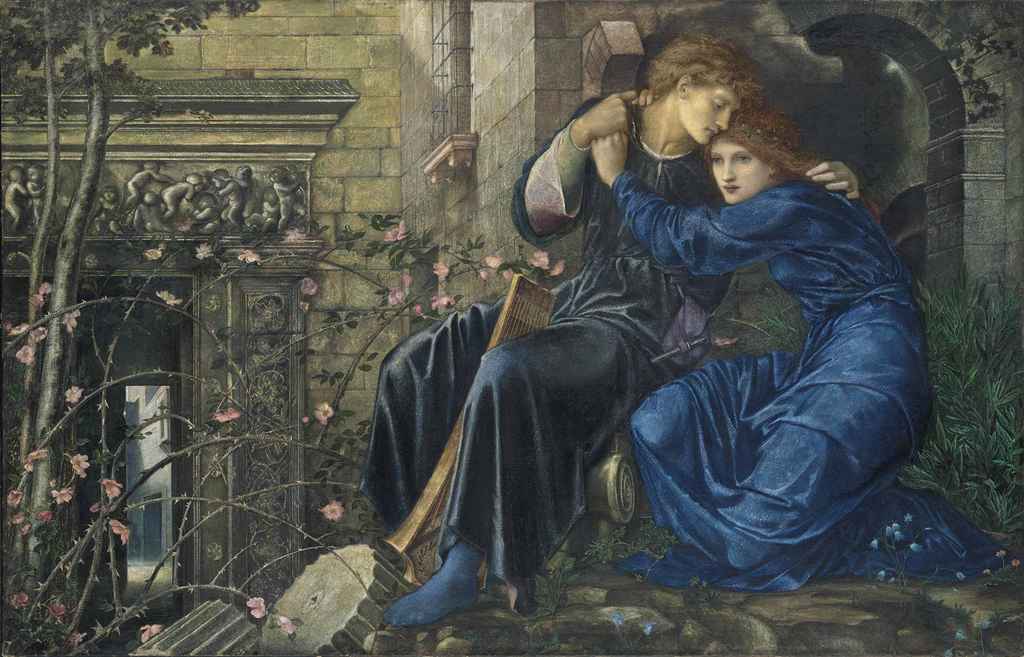
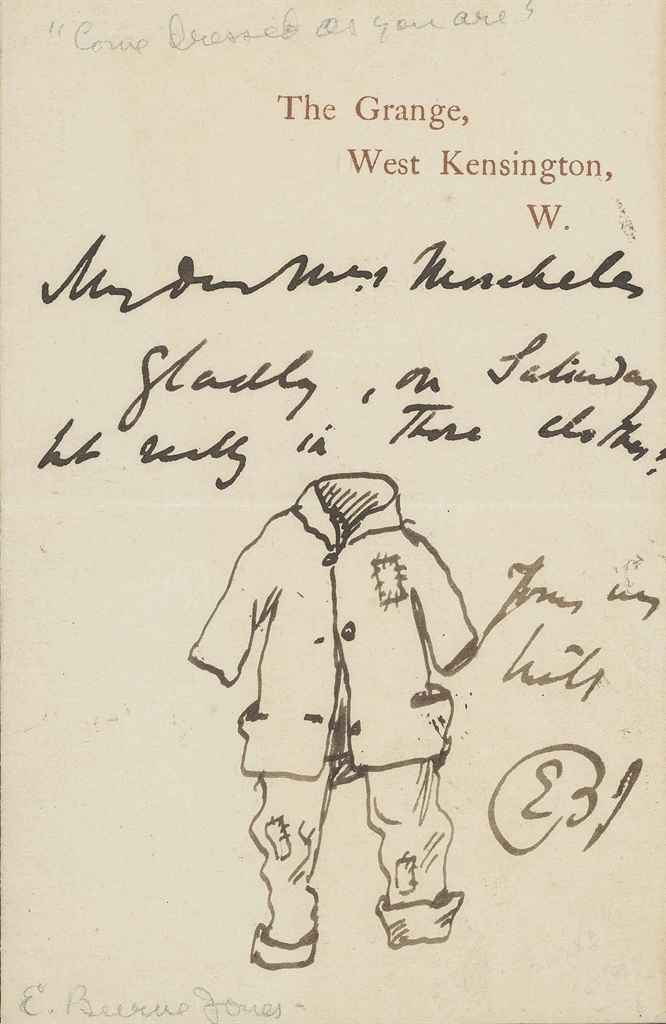
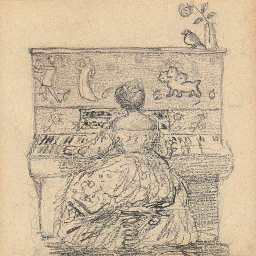
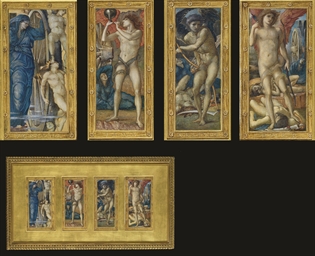
.jpg)
.jpg)

.jpg)
.jpg)

.jpg)
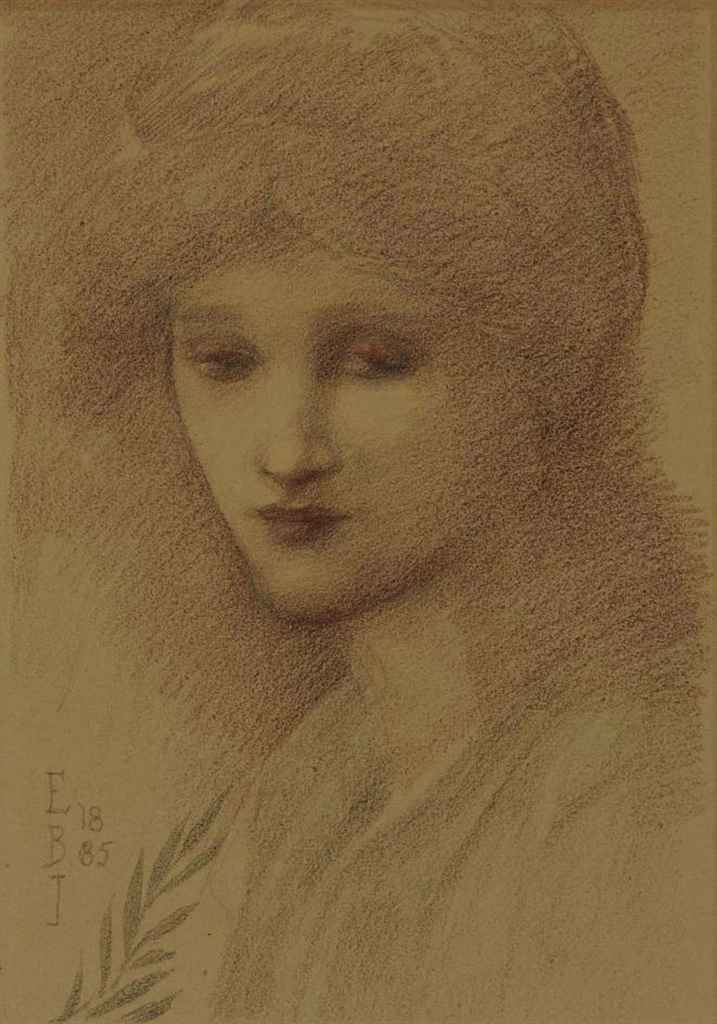
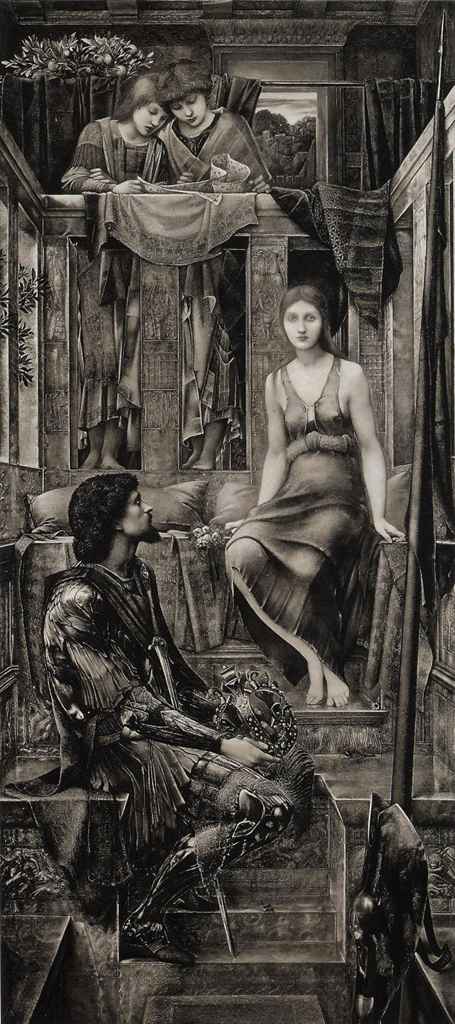
.jpg)
Testen Sie LotSearch und seine Premium-Features 7 Tage - ohne Kosten!
Lassen Sie sich automatisch über neue Objekte in kommenden Auktionen benachrichtigen.
Suchauftrag anlegen